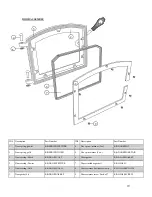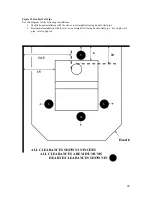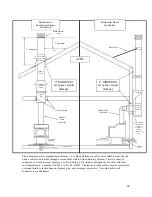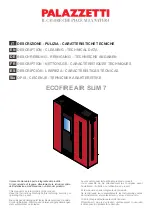
12
STEP 3: Installing the Hearth and Outside air.
CAUTION:
The Kuma Wood Classic Stove can be configured as a Freestanding Stove, supported by
either Legs or a Pedestal Base. Each configuration has different floor protection requirements. See the
section below that pertains to your particular installation.
Minimum Requirements:
The minimum floor protection requirements for the Kuma Wood Classic model are as follows:
Floor protection must consist of a continuous non-combustible material and extend a minimum of 16 in
front of the loading door and 6" to both sides and the rear of the stove body.
Additional requirements for material thickness and thermal resistance are described below.
1.
Wood Classic with Pedestal Base
: Installed as a freestanding stove on a pedestal base the Kuma
Wood Classic requires Ember Protection only. Ember Protection can take the recommended form
of a manufactured Type-1 floor protector listed to UL-1618, or a non-combustible continuous
material with a MINIMUM thickness of 3/8”.
2.
Wood Classic with Legs
: Installed as a freestanding stove on legs the Kuma Wood Classic
requires both continuous ember protection and Thermal Protection with a minimum R-Value of
0.60. Thermal Protection can take the recommended form of a manufactured Type-2 floor
protector listed to UL-1618 with a tested R-Value higher than R = 0.60. Alternately a site built or
existing hearth can be used provided they meet the minimum size and thermal resistance
requirements. Never install this stove with legs on an existing hearth unless you can determine it
provides a minimum thermal resistance of R = 0.60.
CAUTION:
The Kuma Wood Classic Stove can be equipped with an optional Soapstone top Accessory.
When this Model is installed with a Soapstone top, the requirements for hearth protection change. An R-
Value of 0.60 must be
added
to the requirements listed above. See the instructions and safety label that
are included with the Soapstone top Accessory.
Outside Air –
Outside air is required in all manufactured home installations.
1.
Kuma stoves does not particularly require that outside air be directly connected to this
stove,
However, some state or local building codes may mandate outside air. If your state or
local building code requires an outside air supply use part# KA-OUTSIDEAIR. If you are unable
to supply a direct connection to the stove or if you need additional ventilation due to room air
starvation, we suggest the following:
a.
Provide a passive air supply to the home. The air vent should be a minimum of 4” in
diameter.
b.
The air supply must be provided to the same room that the stove is installed in.
c.
The air supply should utilize a barometric damper so that air is only supplied to the room
if the house pressure becomes negative.
Visit
www.woodheat.org
for more information on the use of outside air.
2.
When building a hearth pad on site, be sure to leave an area open for the installation of the
outside air vent.
Once the hearth is positioned according to the minimum clearances, locate and
mark out for the 4” outside are vent. On a pedestal model stove, this hole may be anywhere under
the stove base. On a leg model stove, try and locate the hole to line up with the hole in the bottom
of the stove. On a pre-manufactured hearth, use a hole saw or circular saw to cut through just the
backing board then use a hammer and firmly hit the tile or stone on the top side. If the backing
board was cut to the correct depth, the tile or stone will break out very clean. Also using a hole
saw or circular saw, cut the hole through the home floor into the crawl space. Be sure to line this
hole up with the one in the hearth.













































